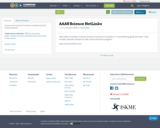
Lessons and tools for K-12 science teaching and after-school programs.
- Subject:
- Applied Science
- Education
- Elementary Education
- Engineering
- Environmental Science
- Life Science
- Material Type:
- Activity/Lab
- Lesson
- Date Added:
- 03/06/2019

Lessons and tools for K-12 science teaching and after-school programs.
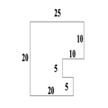
The beginning exercise or assignment for a brand new student
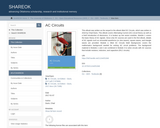
This eBook was written as the sequel to the eBook titled DC Circuits, which was written in 2016 by Chad Davis.
This eBook covers Alternating Current (AC) circuit theory as well us a brief introduction of electronics. It is
broken up into seven modules. Module 1 covers the basic theory of AC signals. Since only DC sources are used in
the first eBook, details of AC signals such as sinusoidal waveforms (or sine waves), square waves, and triangle
waves are provided. Module 2, titled AC Circuits Math Background, covers the mathematics background needed
for solving AC circuit problems. The background material in Modules 1 and 2 are combined in Module 3 to solve
circuits with AC sources that include resistors, inductors, and capacitors (RLC circuits).
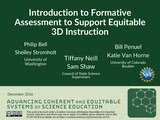
In this professional development session, we will develop a shared understanding of how formative assessment works and different approaches that have been developed. The material for this resource come from a series of PD sessions on formative assessment developed by the ACESSE team: Philip Bell, Shelley Stromholt, Bill Penuel, Katie Van Horne, Tiffany Neill, and Sam Shaw.We will be updating this Facilitator's Guide for ACESSE Resource A with the most up-to-date information about this resource over time. If you encounter problems with this resource, you can contact us at: STEMteachingtools@uw.edu

The NRC Framework for K-12 Science Education and the resulting Next Generation Science Standards focus on an integrated three-dimensional view of science learning in which students develop understanding of core ideas of science and crosscutting concepts in the context of engaging in science and engineering practices.How is assessing three-dimensional science learning different than how we have thought of science learning in the past? How can we design assessment tasks that elicit student’s current understanding of specific aspects of the disciplinary core ideas, science and engineering practices, and crosscutting concepts in order to shape future instruction? In this workshop, participants will learn how to interpret and design cognitive formative assessment to fit a three-dimensional view of learning.This resource originates from a series of PD sessions on 3D formative assessment developed and provided by Katie Van Horne, Shelley Stromholt, Bill Penuel, and Philip Bell. It has been improved through a collaboration in the ACESSE project with science education experts from 13 states. Please cite this resource as follows:Stromholt, S., Van Horne, K., Bell, P., Penuel, W. R., Neill, T. & Shaw, S. (2017). How to Assess Three-Dimensional Learning in Your Classroom: Building Assessment Tasks that Work. [OER Professional Development Session from the ACESSE Project] Retrieved from http://stemteachingtools.org/pd/SessionB
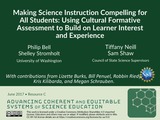
How can science instruction be meaningfullyconnected to the out-of-school lives of students? In this professional development, we will consider how to design formative assessments that build on learners’ interest and knowledge, promoting equity and social justice in the process. The material for this resource comes from a series of PD sessions on formative assessment originally developed by Philip Bell and Shelley Stromholt.We will be updating this Facilitator's Guide for ACESSE Resource C with the most up to date information about this resource over time. If you encounter problesm with this resources, you can contact us at STEMteachingtools@uw.eduThis resource was refined through a 13-state collaboration to make the resource more broadly useful. If you choose to adapt these materials, please attribute the source and that it was work funded by the National Science Foundation (NSF).
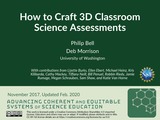
Abstract: This session provides a step-by-step process to support participants as they design a 3D assessment task for the science classroom. Along the way, they learn how to define 3D learning performances for specific lessons—and how to use a range of tools to support their assessment design work. A key goal of the session activity is to improve the connection of intended learning goals to assessment practices. Participants build their 3D assessment design capacity by designing and workshopping tasks—before piloting them in their classrooms. The approaches learned in this workshop can be used with any curricula, at any grade level, and across all subjects of science.
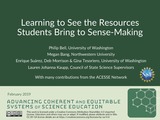
Overview: In this workshop, we will build our capacity to identify the range of intellectual resources students use as they make sense of phenomena. We will first explore how equity and justice relate to culture-based approaches to pedagogy—and then focus on how to identify and leverage the resources students use in moments of sensemaking. This resource can also be used by individuals wanting to learn how equity involves promoting the rightful presence of all students across scales of justice, desettling inequities, and supporting expansive learning pathways. This workshop provides participants with an opportunity to explore important theoretical ideas by exploring examples of how learners engage in diverse sense-making. Participants will learn about some of the challenges that less expansive learning environments can cause for learners from non-dominant communities. This resource is estimated to take between 161-268 minutes (2 ⅔ - 4 ¾ hours), depending on the choices of the facilitator in scenario selection.
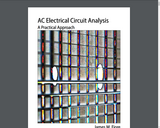
An essential and practical text for both students and teachers of AC electrical circuit analysis, this text picks up where the companion DC electric circuit analysis text leaves off. Beginning with basic sinusoidal functions, ten chapters cover topics including series, parallel, and series-parallel RLC circuits. Numerous theorems and analysis techniques are examined including superposition, Thévenin's theorem, nodal and mesh analysis, maximum power transfer and more. Other important topics include AC power, resonance, Bode plots and an introduction to three-phase systems. Each chapter begins with a set of chapter objectives and includes a summary and review questions. A total of over 500 end-of-chapter exercises are included. A companion laboratory manual is available.
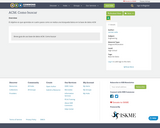
El objetivo es que aprendas en cuatro pasos como se realiza una búsqueda básica en la base de datos ACM
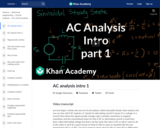
Solving circuits with differential equations is hard. If we limit ourselves to sinusoidal input signals, a whole new method of AC analysis emerges. Created by Willy McAllister.
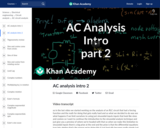
Here's a preview of how AC analysis is going to work. To get ready we need to review some of the ideas from trig and complex numbers. Created by Willy McAllister.
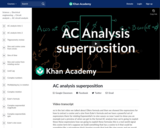
We break a sinusoidal input voltage into two complex exponentials. Using superposition, we can recover the complex output signals and reassemble them into a real sinusoidal output voltage. Created by Willy McAllister.
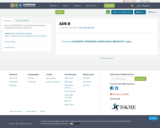
Sources: Riddle1090 document related to Automatic dependent surveillance broadcast.

Machine vision. Data wrangling. Reinforcement learning. What do these terms even mean? In AI 101, MIT researcher Brandon Leshchinskiy offers an introduction to artificial intelligence that’s designed specifically for those with little to no background in the subject. The workshop starts with a summary of key concepts in AI, followed by an interactive exercise where participants train their own algorithm. Finally, it closes with a summary of key takeaways and Q/A. All are welcome!
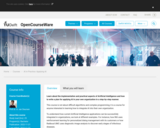
Learn about the implementation and practical aspects of Artificial Intelligence and how to write a plan for applying AI in your own organization in a step-by-step manner.
This course is not about difficult algorithms and complex programming; it is a course for anyone interested in learning how to integrate AI into their own organization.
To understand how current Artificial Intelligence applications can be successfully integrated in organizations, we look at different examples. For instance, how ING uses reinforcement learning for personalized dialog management with its customers or how Radboud UMC uses diagnostic image analysis to discover early stages of infectious diseases.
As part of our two-course program ‘AI in Practice’, this course will guide you in the practical aspects of applying AI in your own organization. You will examine typical applications of AI in use already and learn from their experience. These include challenges of implementation, lifecycle aspects, as well as the maintenance and management of AI applications.
The course presents a variety of case studies from actual situations in public organizations and private enterprises in the healthcare, financial, retail and telecommunications sectors. These include Radboud UMC, the Municipality of Amsterdam, ING, Ahold Delhaize and KPN.
‘AI in Practice – Applying AI’ gives you the ammunition to understand the practical aspects required for the implementation of a variety of AI applications in your organization.
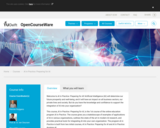
This course, AI in Practice: Preparing for AI, is the 1st course of the online education program AI in Practice. The course gives you a kaleidoscope of examples of applications of AI in various organizations, outlines the state of the art in modern AI research, and provides practical tools for integrating AI into your own organization. The program AI in Practice is built from two initial courses, AI in Practice: Preparing for AI and AI in Practice: Applying AI.
The AI in Practice: Preparing for AI course is designed for people who want to apply AI in their own practical situation.
For the experienced manager who wants to know what AI can do for her own organization.
For the data analyst or business consultant who wants to understand how AI can be applied in the business processes of the company for which they work.
For the student who wants to understand how the results of AI research can be translated into practical applications.
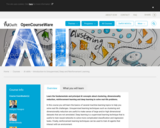
Learn the fundamentals and principal AI concepts about clustering, dimensionality reduction, reinforcement learning and deep learning to solve real-life problems.

Learn the fundamentals of machine learning to help you correctly apply various classification and regression machine learning algorithms to real-life problems.
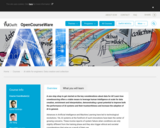
A one-stop shop to get started on the key considerations about data for AI! Learn how crowdsourcing offers a viable means to leverage human intelligence at scale for data creation, enrichment and interpretation, demonstrating a great potential to improve both the performance of AI systems and their trustworthiness and increase the adoption of AI in general.